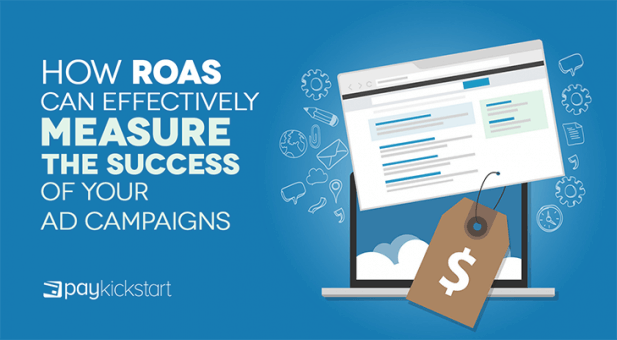Subscription growth hack (by PayKickstart)
Facebook Group - 3,932 members
Visit Group
Using data to measure performance is vital, especially when it comes to digital ad campaigns. If you’re spending a lot on marketing but aren’t generating solid returns, you could end up wasting a lot of money. Further, some ad campaigns will simply do better than others. By knowing which campaigns are most effective, you can direct your resources to where they’ll best be put to use.
An example of a PayKickstart ad. We’ve honed our ads over the years to find the most effective messaging.
Of course, you might wonder how you define the success of a digital marketing campaign. One way to do so is to measure your Return On Advertising Spend or ROAS for short. As far as advertising metrics go, ROAS is one of the most effective measurements you can use.
That being said, there are some limitations to ROAS and you shouldn’t use the metric on its own. Instead, this metric should be part of your larger data-driven strategy. Let’s take a look at ROAS, how you can use it to measure the success of your campaigns, and also some limitations you should keep in mind. We’ll also go over how you can begin developing a holistic data-driven strategy.
Return On Advertising Spend is used to measure the efficacy of a digital marketing campaign. This includes social media campaigns, Google Adwords, and more. By using ROAS, you can determine which methods, tactics, and campaigns are producing good returns, and which are providing poor returns.
The ROAS formula is very simple and straightforward. Simply take the Gross Revenue produced by an ad campaign and divide it by the cost of the campaign. Let’s say you spent $1000 dollars on a campaign one month and it generated $5,000 in revenues. You could calculate your ROAS like so:
The result is a 5:1 ratio. In other words, for every dollar you spent, you produced $5 in revenue. That’s a pretty good ratio. On the other hand, imagine if you spent $4,000 dollars to produce $5,000 in additional revenues. You’d get a 4:5 ratio, which isn’t nearly so attractive.
What’s a good ratio? This really depends on your company, how profitable your products and services are, your immediate goals, and various other factors. However, a common rule of thumb for ROAS is 4:1. Keep in mind that this is a rule of thumb and may not hold true for your company, situation, or goals.
ROAS helps you understand how effective each campaign is. One way to use ROAS is to calculate it for each campaign so that they can then be measured against one another. This is especially effective when you’re using multiple campaigns to sell a single product or service.
At PayKickstart, we’re currently selling only one product, our online shopping cart. Yet we use multiple channels and often run several different campaigns on our channels. We can use ROAS to see what is producing the best returns. We can compare Google Ad campaigns against each other, and also different channels, such as Facebook versus Bing Ads.
Different channels will produce different results.
If one campaign is enjoying a 6:1 ratio, while another only gets 2:1, then you know where you should allocate your budget. Likewise, if Google Ads is producing a 5:1 RAOS ratio, while Facebook is producing only 3:1, we know which channel is performing better.
Should you find you’re spending more money on ads than you’re generating in revenue, then you know you have a serious problem and need to reconsider your strategy. Still, while ROAS is very useful, there are also many limitations. Speaking of which…
You can rarely rely on one metric to measure outcomes. This is especially true for digital marketing. ROAS is undoubtedly one of the more important measurements for your digital marketing campaigns. However, in some ways, ROAS is limited in scope.
For example, ROAS doesn’t consider profit margins. Let’s say you sell products that have a low-profit margin. Your $100 dollar Acme Gizmos, for example, cost $90 dollars to acquire. If you spend $1,000 on an ad campaign to sell 500 gizmos, you’ll produce $5,000 in additional sales, but just $1,000 in gross profit. Given how much you spent on your ad campaign, you don’t actually make a profit.
If your gizmos carry a low-profit margin, it’ll be harder to profit off ad-driven campaigns.
Then there’s customer lifetime value (CLV), another very important metric that ecommerce and SaaS companies should pay attention to. Let’s say you sell Software-as-a-Service and your “Amazing Task Manager” costs $10 bucks a month. Let’s assume you spend $1,000 on a marketing campaign and get 90 new customers to sign up, generating $900 in additional revenue.
Wait! You’re in the red! You actually lost $100. Or did you? If customers sign up for your SaaS and pay month after month, their Customer Lifetime Value (CLV) will actually be much higher. Let’s say the average customer signs up for 24 months, thus generating $240. This means the total lifetime value of those 90 signups could be $21,600!
As you can see, if you want to use ROAS to effectively measure ad campaigns, you need to take the above and more into consideration.
So what’s the take away from all of this? Return On Advertising Spend is certainly an effective metric and one that every digital marketer should pay attention to. Fortunately, ROAS is easy to calculate. However, by itself, ROAS doesn’t tell us very much.
On its own, Return on Ad Spend is perhaps most effective when comparing different campaigns and channels for the same product or service (in the same time frame). But even then, you’re only comparing campaigns or channel versus one another and you’re not taking your total strategy and the “big picture” into consideration.
ROAS is a vital component and key measurement, however, for understanding the big picture. By combining ROAS with customer lifetime value, profit margins, and various other metrics, you’ll be able to more effectively allocate resources. This, in turn, will help ensure your company’s success.
Michael Harbone is an experienced copywriter, writing professionally since 2017. He has written for multiple digital marketing companies gaining the reputation for writing engaging, concise articles one which received an award from Upcity.
Read More About Michael Harbone
